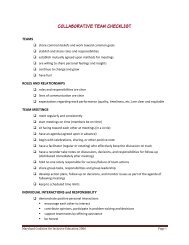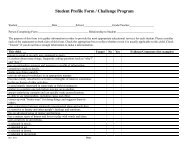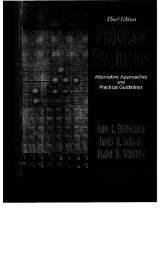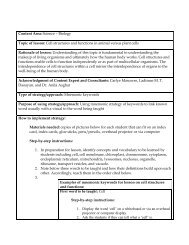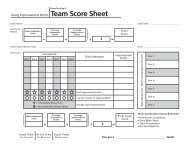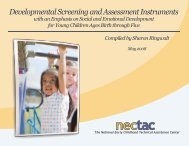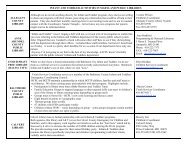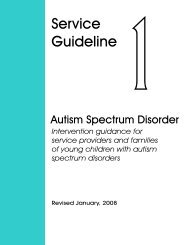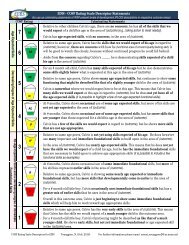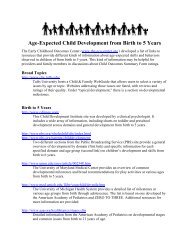Rous, B. (n.d.). <strong>Early</strong> childhood transition resources and practices: Annotated bibliography.Lexington, KY: University of Kentucky, Interdisciplinary Human Development Institute,National Center for Collaborative Planning. Retrieved March 25, 2004 fromhttp://www.ihdi.uky.edu/stepsweb/Transition - Bibliography.pdfABSTRACT: This annotated bibliography provides information on publications related to researchand practice in the area of early childhood transition for young children from birth to age eight.Information is presented on the following topics: transition overview, program design, crossprogram/agency activities, families, policies and supports, and evaluating the process. Includes amatrix that summarizes the information presented and topics covered within the document.Rous, B. (1997). Project STEPS: Assessment of current transition practices and transition systemdevelopment plan. Lexington, KY: Child Development Centers of the Bluegrass, Inc.ED423629.ABSTRACT: This set of forms is part of Project STEPS (Sequenced Transition to Education in thePublic Schools). They are intended to assist communities develop and use a formalized process forassessing the current status of transition within their community and for interagency planningrelated to the development of a community-wide transition team. The forms are to be completed bya community team during a three-day intensive inservice training session. The inservice processinvolves three steps: (1) completion of the team vision and scope statement; (2) assessment of thecurrent status (whether formalized policies and procedures are in place, partially in place, or not inplace); and (3) development of the transition system plan, including choice of activities forimplementation, timelines for completion, and assignment of responsible individuals. Theassessment process involves evaluation of current administrative structure, the InteragencyCommittee, staff development, family involvement, and child transition.Rous, B., Hemmeter, M. L., & Schuster, J. (1994). Sequenced transition to education in the publicschools: A systems approach to transition planning. Topics in <strong>Early</strong> <strong>Childhood</strong> SpecialEducation, 14(3), 374-393.ABSTRACT: This article describes a model project for promoting interagency collaboration at stateand local levels to facilitate transitions of young special needs children and their families frominfant/toddler programs to preschool programs. Project Sequenced Transition to Education in thePublic Schools (STEPS) has four major components: interagency involvement, staff involvement,family involvement, and child preparation.Rous, B., Hemmeter, M. L., & Schuster, J. (1999). Evaluating the impact of the STEPS model ondevelopment of community-wide transition systems. Journal of <strong>Early</strong> <strong>Intervention</strong>, 22(1),38-50.ABSTRACT: A study investigated effects of training related to using the Sequenced Transition toEducation in the Public Schools model (STEPS) on the development of community-wide transitionsystems. Seven teams composed of public schools, Head Start, and early intervention representativeswere trained. Change occurred as a result of the training.page 6
Sarathy, P. (2003). “Together we succeed”: Building a better system for transitioningpreschoolers with disabilities. Horsham, PA: LRP Publications.ABSTRACT: This guide offers creative ideas and strategies for developing and implementing abest-practice system to achieve smooth transitions from one service delivery model to another foryoung children with special needs and their families. It focuses on three major transitions for thechild and the family during the early childhood years including: the transition from early intervention(EI) services to preschool special education services, transitions while receiving preschoolspecial education services, and the transition from preschool to school-age services. The objectivesof the guide are to: (1) provide an overview of the differences between EI services and preschoolservices, and between preschool services and school-age services; (2) outline requirements of thelaw to achieve smooth transitions for young children with disabilities and their families; (3) discusstransition challenges and issues, and how transition impacts different stakeholders involved; (4)present systemic, research-based strategies for overcoming challenges and promoting effectivetransition practices; (5) present Together We Succeed (TWS), a multi-pronged systemic approach totransition planning; (6) provide a variety of activities to implement TWS, with a practical step-by -step approach on how to execute the activities and case examples to supplement and reinforce theactivities; (7) provide flowcharts, checklists and surveys associated with the implementation of theTWS activities, which can be copied, modified and adapted to suit local needs; (8) identifyevaluation procedures to monitor the success of the transition process system.Swedeen, B. (2001). Birth to three transition: One family’s story. Young Exceptional Children,4(2), 12-14.ABSTRACT: A mother discusses her family’s experience in transitioning her daughter from earlyintervention services to an early childhood program. Helpful strategies that the early childhood staffused are identified and include introducing families to teachers during the transition process andallowing parents to visit the program before sending their child.U.S Head Start Bureau. (2000). Effective transition practices: Facilitating continuity. Trainingguides for the Head Start learning community. Washington, DC: U.S. Dept. of Healthand Human Services, Administration for Children and Families, Administration onChildren, Youth, and Families, Head Start Bureau. Retrieved March 25, 2004 fromhttp://www.headstartinfo.org/publications/effective_transitions/index.htmABSTRACT: This foundation guide familiarizes all staff with the elements and requirements ofeffective transition; increases staff and parent skills that support children and families preparing fortransition and helps staff and families identify specific practices to support transition.U.S. Head Start Bureau & Aspen Systems Corporation. (1999). Infant and toddler transitions.Training guides for the Head Start learning community. Washington, DC: U.S. Dept. ofHealth and Human Services, Administration for Children and Families, Administrationon Children, Youth, and Families, Head Start Bureau. Retrieved March 25, 2004from http://www.headstartinfo.org/publications/infant-toddler_transitions/index.htmABSTRACT: <strong>Early</strong> Head Start and Head Start families, managers, and staff are aided in developingskills and practices that support the healthy development and transitions of infants and toddlers andtheir families. Through this technical training guide, staff and families learn to examine infant andtoddler transitions from a developmental perspective; individualize routines and practices to supporteach child’s needs; plan for transitions that ensure consistency and continuity; and implement measuresfor evaluating the quality and effectiveness of transitions.page 7




